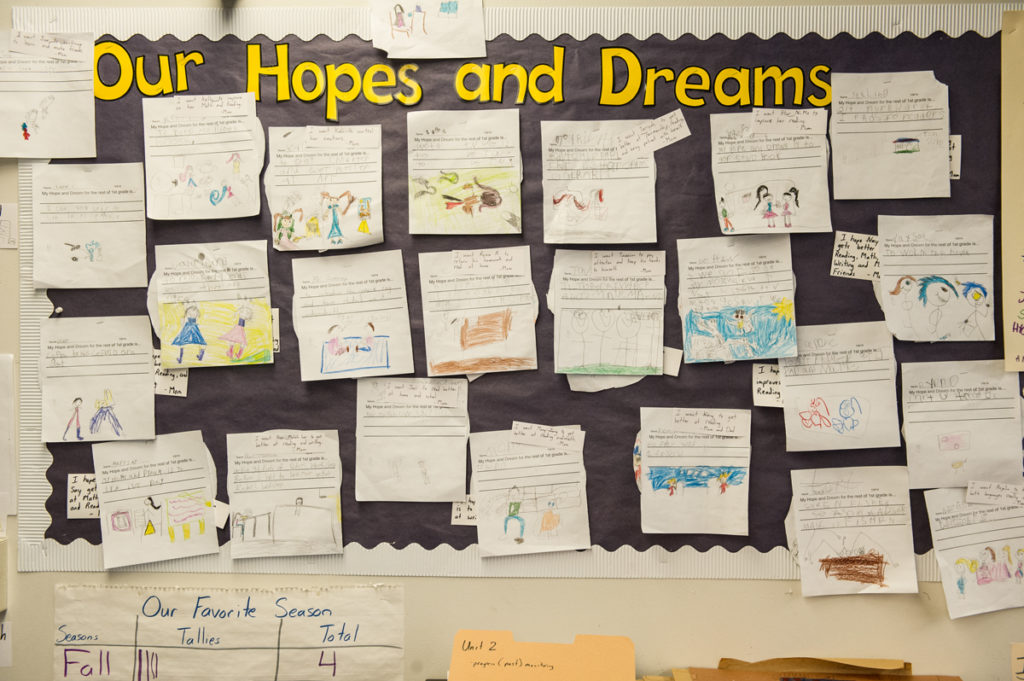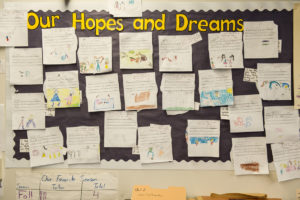

One of the ways I launch each school year is with the process of creating hopes and dreams (see lead article for an overview). In my classroom, the process takes several weeks and involves lessons in literacy and math along with learning about school expectations, classmates, and how we’ll work together as a group.
I find that taking my time with this process is essential to making it meaningful for children this age. Before ever beginning a discussion of hopes and dreams, I take time to explore and expand children’s ideas about what they’ll be doing in first grade.
During the first few weeks, we read and discuss books about first grade, school, friendships, and learning. Here are some of my personal favorites:
Leo the Late Bloomer by Robert Krauss
Franklin Goes to School by Paulette Bourgeois
My Friends by Taro Gomi
Friends at School by Rochelle Burnette
Lilly’s Purple Plastic Purse and
Chrysanthemum, both by Kevin Henkes
As we read and reflect on these stories, children expand their notions about school. They also begin to get to know one another and feel comfortable sharing their ideas in a group. Many of my students come to school with limited verbal skills. Reading and discussing books is a great way for them to build their vocabulary and get more comfortable expressing themselves verbally. Then when the time comes to share hopes and dreams, they can do so in a genuine way.
While reading these books about school, we also explore our school environment. During the first two weeks, we take whole-group tours of the school. We also tour each center in our classroom, visiting the math center, science/ social studies center, writing center, library area, listening center, and art cart. Students notice the supplies and materials found there and offer ideas about what kind of learning might take place at each center. We complete these classroom tours by choosing a good spot for each center’s label.
Once students are comfortable with the classroom and their classmates, I begin the discussion of hopes and dreams. This conversation typically occurs over many days. I might begin by asking a general question about hopes, such as “What does it mean to hope for something?” or “Have you ever hoped for anything?”
Then I ask students to think specifically about what they hope for in first grade. Each day, five students respond while I record their words on chart paper. I feel it’s important to keep this activity short, even though this means it takes a good four to five days to get everyone’s input. Many six-year-olds have a hard time sitting for longer than fifteen minutes in the beginning of the year.
To integrate early literacy skills, I use a repeating pattern of text to record children’s ideas. For example, I might write:
Mary said, “I hope I learn to read books.”
Joey said, “I hope I learn to count to 100.”
Anita said, “I hope I make lots of friends.”
Each day we re-read the list as a group before adding more students’ hopes until everyone has had a chance to contribute. In the process, students begin to recognize one another’s names and common sight words.
I want children’s hopes to be related to school and to be attainable. When introducing hopes and dreams, I ask students to think specifically about things they hope to do or accomplish this year in school.
Still, some children will need more guidance making their hope school-related. When a child expresses a hope such as wanting “to learn to ride a big bike” or for “my dad to come back soon,” I acknowledge the importance of the hope and ask him/her to think of another hope that can be achieved in school. This is essential because these hopes and dreams will later become the springboard for creating classroom rules.
Each year we create a bulletin board display of the children’s hopes and dreams so that we can refer to them all year. Last year I decided to create a paper hopes and dreams quilt to hang over an old chalkboard we never use.
First, I laid butcher-block paper over long worktables for children to make first draft illustrations of their hopes for the year. As they drew, I wrote their sentences next to the illustrations and then asked them to point to the words and read the sentence with me. Later they did the same with a partner. The children enjoyed the process of working side-by-side with classmates and sharing their pictures and hopes informally with one another.
Next I cut a paper quilt square for each child and typed his/her sentence on it. When students received their squares, I asked them to read the sentence to themselves and to ask for help if they had trouble with any words. They then read their sentence aloud to the group. Because children had practiced reading to themselves first, they were able to read to the group quickly and confidently. Now the students were ready to do their final illustrations on their quilt squares.
Understanding that these pictures would be displayed in the classroom, children were eager to do their best work. This provided a good opportunity to talk about what it meant to do quality work. Students offered ideas about making the picture go with the words, making it colorful and detailed, and taking their time. As children worked, I moved from table to table, noticing and encouraging their efforts. As children finished, they shared their quilt piece with classmates.
The final step was to make the border for each quilt piece using shapes and patterns. This activity dovetailed nicely with our math curriculum. Children glued their quilt pieces onto the center of another paper square. They then created different patterns around the border using pattern blocks. Once they found a pattern they liked, they copied the pattern onto the border using crayons or colored pencils.
We placed the squares onto a large red sheet of butcher-block paper and proudly hung our quilt on the wall. The children had worked hard and had learned a lot about classmates, school expectations, working together, reading, writing, and shapes and patterns. We were well on our way to building a sense of community and ready now to create our classroom rules. That would be the work of the coming weeks.
Paula Stafford has been teaching first grade at Murphy School in Chicago, Illinois, for eight years. Prior to becoming a first grade teacher, she taught preschool and Head Start in southern California and Illinois.